FAA Private Pilots Written
1/305
There's no tags or description
Looks like no tags are added yet.
Name | Mastery | Learn | Test | Matching | Spaced |
|---|
No study sessions yet.
306 Terms
Which aircraft construction material combines two or more materials together to make a structure that is much stronger than the individual components?
Composite
In addition to wire-braced wings, what identifies open truss structure?
Clearly visible struts
Which fuselage design cannot tolerate dents or deformations of the surface?
Monocoque
Which wing design contains no external bracing?
Cantilever
A conventional empennage always contains what two components?
Vertical stabilizer, or fin, and a horizontal stabilizer
What small hinged device on an airplane is used to help minimize the pilot's workload?
Trim tab
Aircraft brakes are located on which wheels?
Main wheels
Most general aviation airplane propellers have how many blades?
2 or 3
Where are the required operating limits and weight and balance records for a particular aircraft found?
Pilots Operating Handbook (POH)
What is the other accepted name for the pilot's operating handbook (POH)?
FAA Approved Flight Manuel
Using the ISA standards for altitude change, if an aircraft is at 4,000 feet and 10 degrees C, what will the temperature be if the aircraft increases to 10,000 feet?
-2 degrees C
What is the pitot-static system used for?
To determine speed, altitude, and altitude trend
The pitot-static system generally consists of what two components?
The pitot tube and pitot-static instruments
Vso
Airspeed indicator: Lowest limit of the white arc, the stall speed or the minimum steady flight speed in the landing configuration.
Vs1
Airspeed: Lowest limit of the green arc, the stall speed or minimum steady flight speed obtained in a specific configuration
Vfe
Maximum speed with the flaps extended. Upper limit of the green arch
Vno
Upper limit of the green arc, the maximum structural cruising speed
Va
Design maneuvering speed. Listed in POH. Speed you can use full control movement and not cause structural damage to the aircraft. It changes with aircraft weight. It's greater when aircraft is heavy and lower when the load is light.
Vlo and Vle
Max landing gear operating airspeed and maximum landing gear extended airspeed
Indicated airspeed (IAS)
On airspeed indicator. It's calibrated for sea level conditions.
Doesn't reflect variation in air density.
Importance performance airspeeds are always the same indicated airspeed, regardless of altitude.
Calibrated airspeed (CAS)
Indicated airspeed corrected for installation error and instrument error.
Determine by looking at chart in the POH.
True airspeed (TAS)
Actual speed through the air. Calibrated airspeed corrected for density changes due to altitude and temperature.
Use flight computer to determine.
Groundspeed
Actual speed over the ground.
TAS and Groundspeed are equal in a no wind situation.
- A headwind decreases groundspeed
- A tailwind increases groundspeed
- It is not on the airspeed indicator
Vn
Maximum structural cruising speed
What is the altimeter?
It measures the aircraft's altitude and is part of the pitot-static system.
- Indications are based on the mean sea level (MSL)
-Change the Kollsman window to compensation for changes in local pressure.
-Indicated altitude changes about 1,000 feet for every inch of change in the setting.
-Altimeter settings are accurate only in the vicinity of the reporting station.
What do the dials on the altimeter mean?
The longer of the two needles indicates multiples of 100 feet.
The shorter of the two needles indicates multiples of 1,000 feet
The pointer indicates multiples of 10,000 feet
- A crosshatched area appears at altitudes below 10,000 feet MSL
What is the Kollsman window?
The altimeter setting window. Turn the know to a higher setting increases the indicated altitude. Changes 1,000 feet for every inch of change in the setting.
What are the 6 main types of altitude?
Indicated altitude
Pressure altitude
Density altitude
True altitude
Absolute altitude
Calibrated altitude
Indicated Altitude
The altitude measured by the altimeter, the altitude used most often during flight.
-
Pressure altitude
The height above the standard datum plane.
The standard datum plane is a theoretical reference point at sea level where pressure is 29.92 of mercury.
Used to compute density altitude, true altitude, true airspeed and other performance data
Density Altitude
Pressure altitude corrected for temperature.
When conditions are standard, Density and Pressure altitude are the same.
If temp is higher, the density altitude is higher than pressure altitude
If the temp is lower, density altitude is lower than pressure altitude
It is important because it's directly related to aircraft performance.
True altitude
The vertical distance above the mean sea level.
Absolute altitude
The actual height of the aircraft above the earth's surface, commonly referred to as height AGL.
It varies based on the height of the surface over which the aircraft is flying.
What are three conditions that can cause a false altimeter indications
1. Failing to keep the altimeter set
2. Flying from high pressure to low pressure
3. Not monitoring the temperature
What is the ISA standard atmospheric pressure at sea level
14.7 lb
29.92 inches of mercury
-Standard pressure lapse rate is 1 inch of mercury (hg) per 1000 feet
What is the ISA standard atmospheric temperature at sea level
59 degrees f
- Standard temperature lapse rate is 2 degrees for every 1,000 ft
What is the vertical speed indicator (VSI)?
Part of the pitot-static system
- Static pressure
- Measures rate at which an aircraft gains and loses altitude
- Indicates 0 when you're flying level
- Displays trend and rate
What are the most common instruments that contain gyroscopes
Turn coordinator
Heading indicator
Attitude indicator
What are the properties of rigidity in space?
- Tends to remain rigid
- Resists external forces
- Fixed position in space
What effects does precession have on gyroscopic instruments
Precession is the tilting or turning of a gyro in response to pressure.
Causes:
- Slow drifting and minor error indications
- Reaction in the direction of rotation
What is the turn coordinator?
It indicates turn direction and quality of the turn.
Also, serves as a backup source of bank information in the event of attitude indicator failure.
Two components: Turn indicator and Inclinometer
What is a standard rate turn?
3 degree per second turn.
The ball should remain centered.
What is a slip and a skid?
Slip: The rate of turn is too slow for the angle of bank and the ball moves to the inside of the turn.
Skid: The rate of turn is too great for the angle of bank, and the ball moves to the outside of the turn.
"step on the ball" with the rudder pressure.
What flight conditions does the turn coordinator display?
Standard-rate turn and coordinated flight
Attitude Indicator
Pitch and roll. Is an artificial reference for pitch and roll attitude with respect to the earth's surface.
Useful when the horizon is not visible (storms, night time, etc)
Set the indicator while on the ground.
Heading indicator
360 degree compass
It does not have an automatic north-seeking capability.
It must be set before each flight and periodically adjusted throughout the flight.
How are gyroscopic instruments powered?
Most use a combination of electrical and vacuum power to provide a backup in case one system fails.
Turn coordinator is typically electrically powered.
Attitude and heading indicators normally receive power from a vacuum system.
What is the magnetic compass used for?
- Indicate the magnetic heading of the aircraft
- Set the gyroscopic heading indicator to correct for precession
- Back up the heading indicator
It's the only direction seeking instrument in the aircraft.
Variation
The angular difference between true north and magnetic north.
Convert true course to magnetic course, subtract easterly variation and add westerly variation.
"East is least, west is best"
Isogonic Lines
Lines on an aeronautical chart that connect points of equal magnetic variation.
Agonic Line
The line that connects points where the magnetic variation is zero.
Deviation
A compass error caused by magnetic disturbances from electrical and metal components in the aircraft.
There's a compass correction card to correct for deviation. Tells you the correction if radio is on or off
Acceleration/Deceleration Error
In northern hemisphere, when your aircraft accelerates, the compass indicates a turn to the north.
When you slow, the compass indicates a turn to the south.
ANDS: Accelerate North, Decelerate South
These errors do not occur when you fly on a north or south heading.
Digital Displays
Aka Glass cockpit
Screen is called Primary Flight Display (PFD)
All 6 instruments are shown here.
Turn coordinator is combined with the attitude indicator
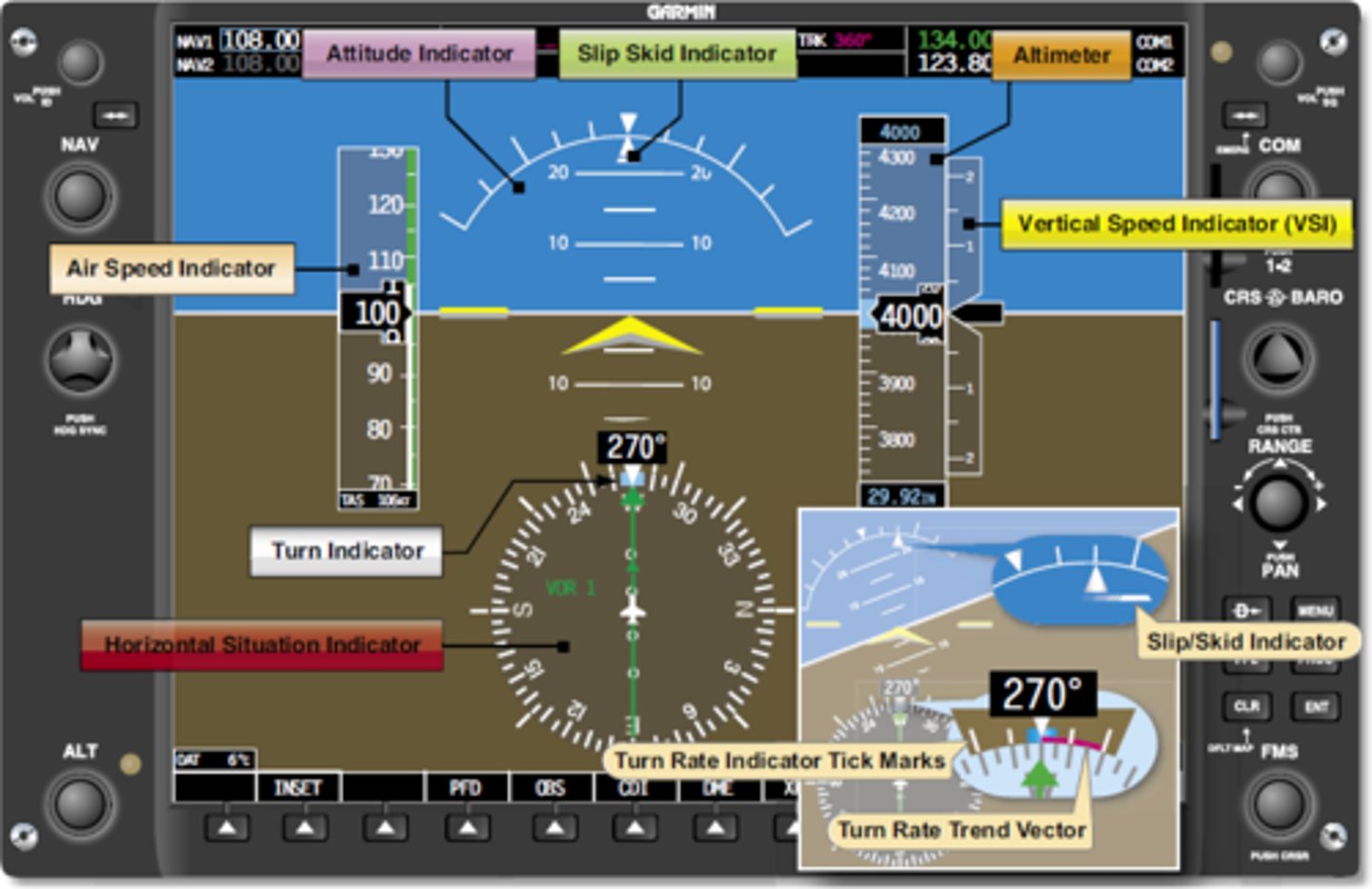
Colors on digital display airspeed indicator
Solid red indicates the aircraft is within 20 knots of stalling speed
Yellow - aircraft is approaching stall speed
White - flap operating range
Green - normal operating range
Another yellow tape - the caution range
Red and white diagonal stripes - the never exceed speed
Vertical Speed Indicator
Airplane's rate of climb or descent.
It begins to operate whenever the climb or descent rate exceeds 100 feet per minutes.
Major, numbered tick marks represent 1,000-foot increments
Minor, unnumbered tick marks represent 500-foot increments
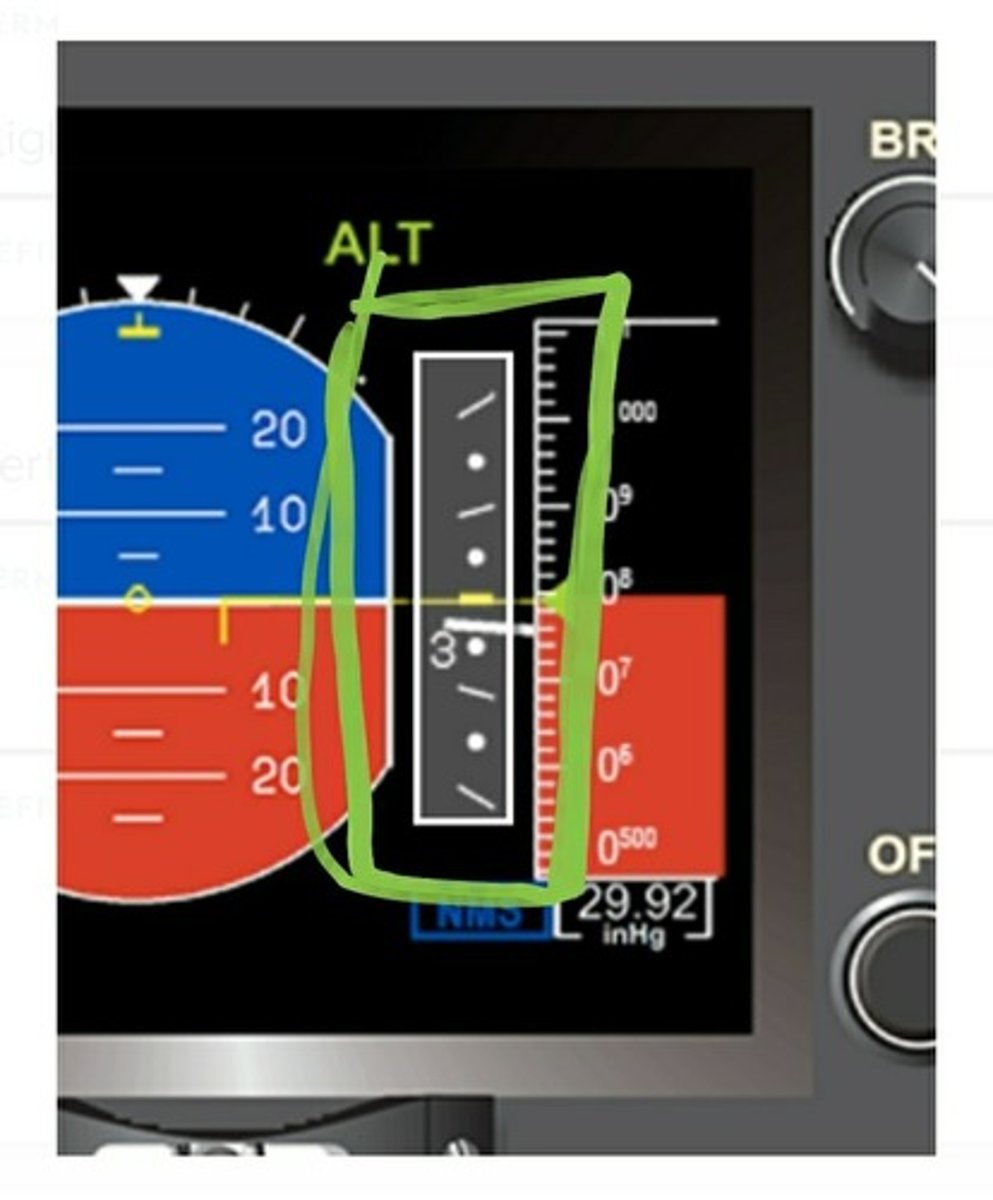
Digital attitude indicator
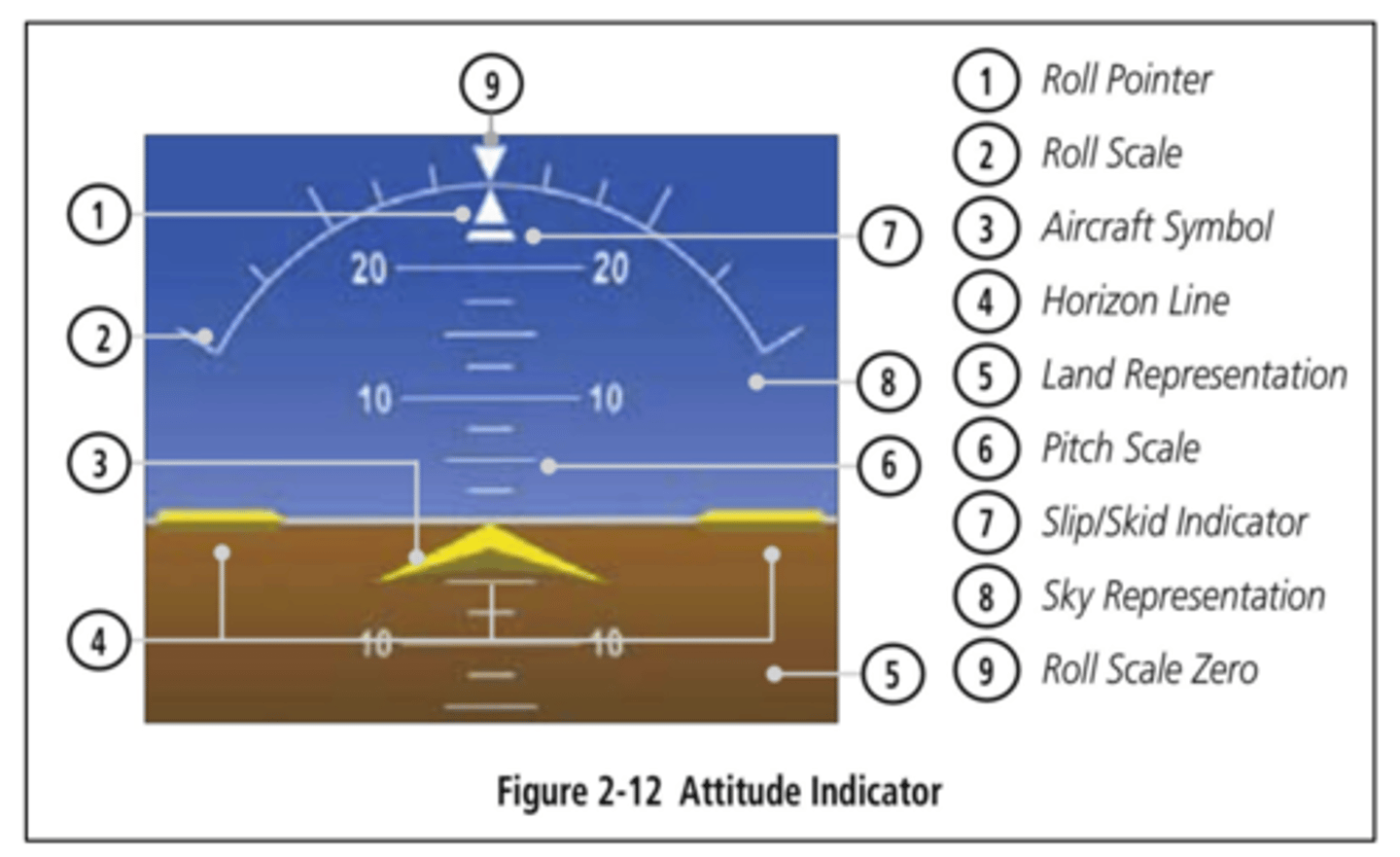
Digital Turn coordination
The ball is shown as a trapezoid. Shifts to the left or right to indicate slipping or skidding.
"step on the trapezoid"
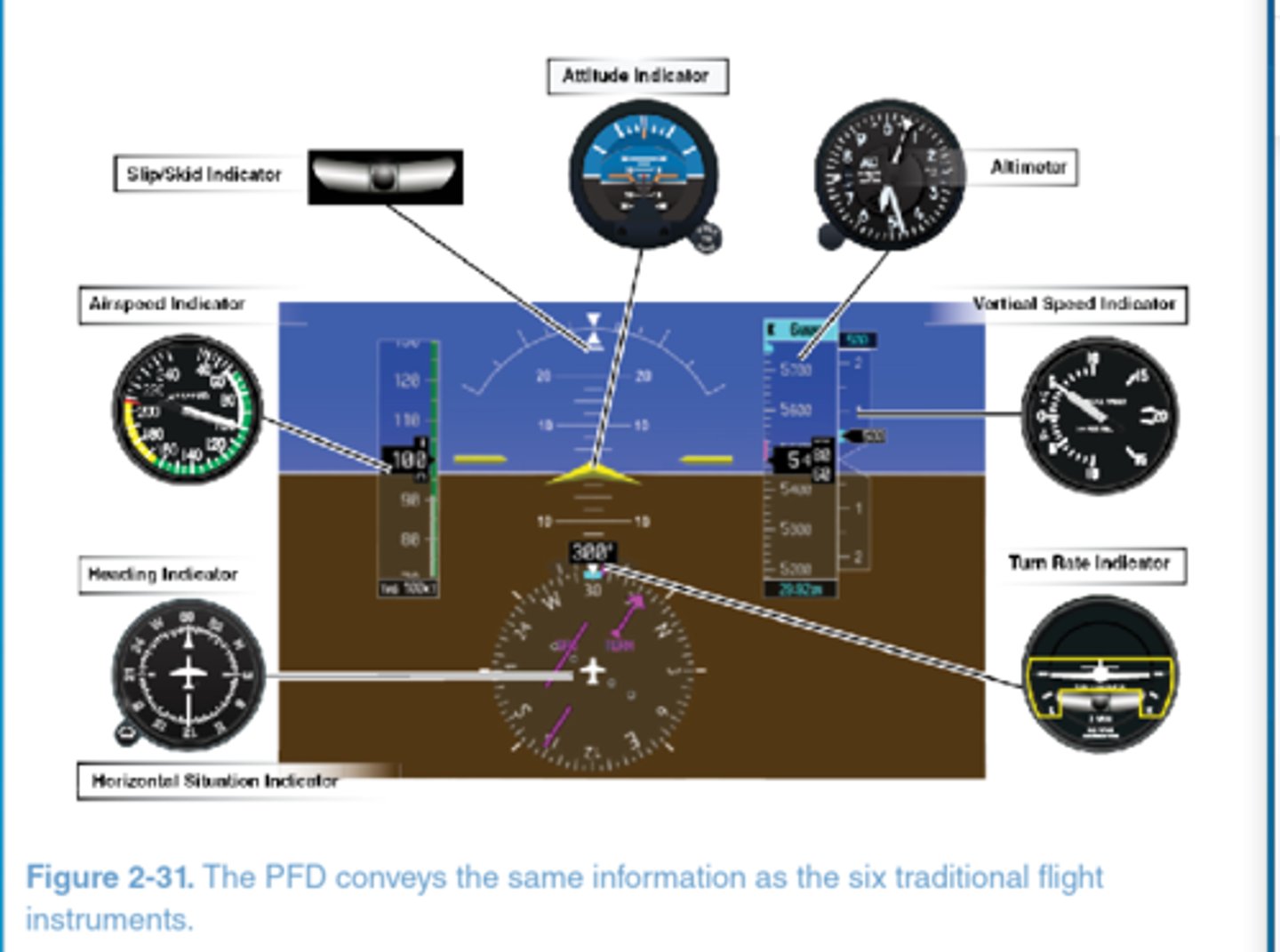
Horizontal situation Indicator
Heading indicator.
Displays movement and heading information using electronic 360 compass card.
HSI is self adjusting
Which type of airspeed is important to performance, regardless of altitude?
Indicated
What does AGL refer to?
Height above the ground
If the pitot tube and its associated drain hole become completely blocked but the static system remains open, what happens to the airspeed indication?
The airspeed indication will vary as altitude changes.
Which instrument would continually indicate zero when a static system blockage occurs?
Vertical speed indicator
What is meant by rigidity in space?
The principle that a wheel with a heavily weighted rim spun rapidly will remain in a fixed position in the plane in which it is spinning
What analog instrument feature is combined with the turn coordinator in a digital display?
Attitude indicator roll pointer
What are the four atmospheric layers
Troposphere - closest to earth, layer you fly in. contains most of water vapor, cloud cover and winds. Earth to 36,000 feet
Stratosphere - only high performance aircraft, commercial aircraft, and military aircraft. From Troposphere to 160k feet
Mesosphere - no aircraft fly here. has little influence on whether
Thermosphere - space shuttles fly here. Has no influence on weather. >250k feet
TSMT
Troposphere
closest to earth, layer you fly in. contains most of water vapor, cloud cover and winds. Earth to 36,000 feet
Temp decreases 2 decreases 2 degrees celsius for every 1,000 fee to about -51 degrees c
It is elliptical and its altitude varies with latitude and the season.
Lower near the poles and higher near the equator
During winter months, the altitude of the troposphere over the poles is lower, during summer months the altitude increases over the equator
Tropopause
The boundary between the troposphere and the stratosphere.
Acts as a lid to contain water vapor and the associated weather within the troposphere.
Composition of the Atmosphere
21% Oxygen
1% Other Gases
78% Nitrogen
Water Vapor responsible for major changes in the weather (cloud snow and ice)
What is convection
Process of transporting heat from warmer areas to cooler areas.
Air is heated at equator and moves towards cooler areas at the poles.
As the air cools in the poles, it then moves back towards the equator.
The circulation process continues as the surface of the earth heats and cools.
Three Cell Circulation Patterns
Hadley cell
Polar cell
Ferrel cell
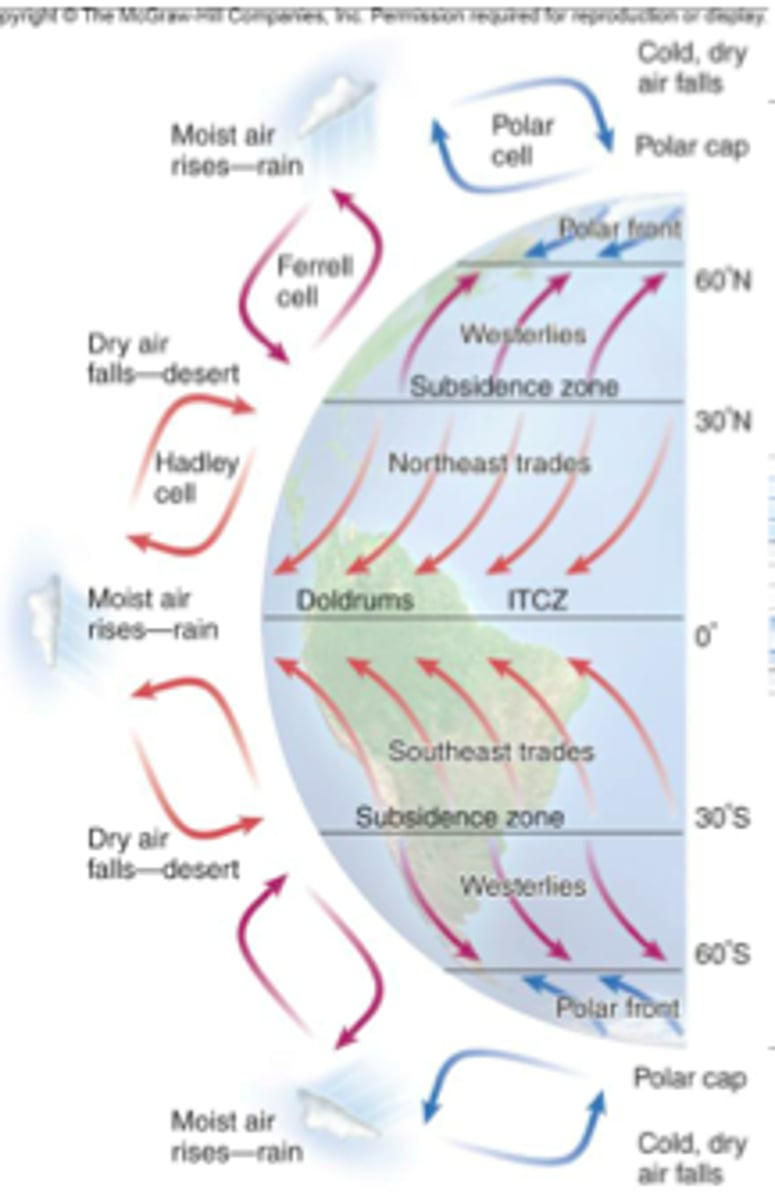
Hadley cell
Convection Currents that cycle between the equator, 30 degrees North and South.
Air rises at the equator and flows toward the poles.
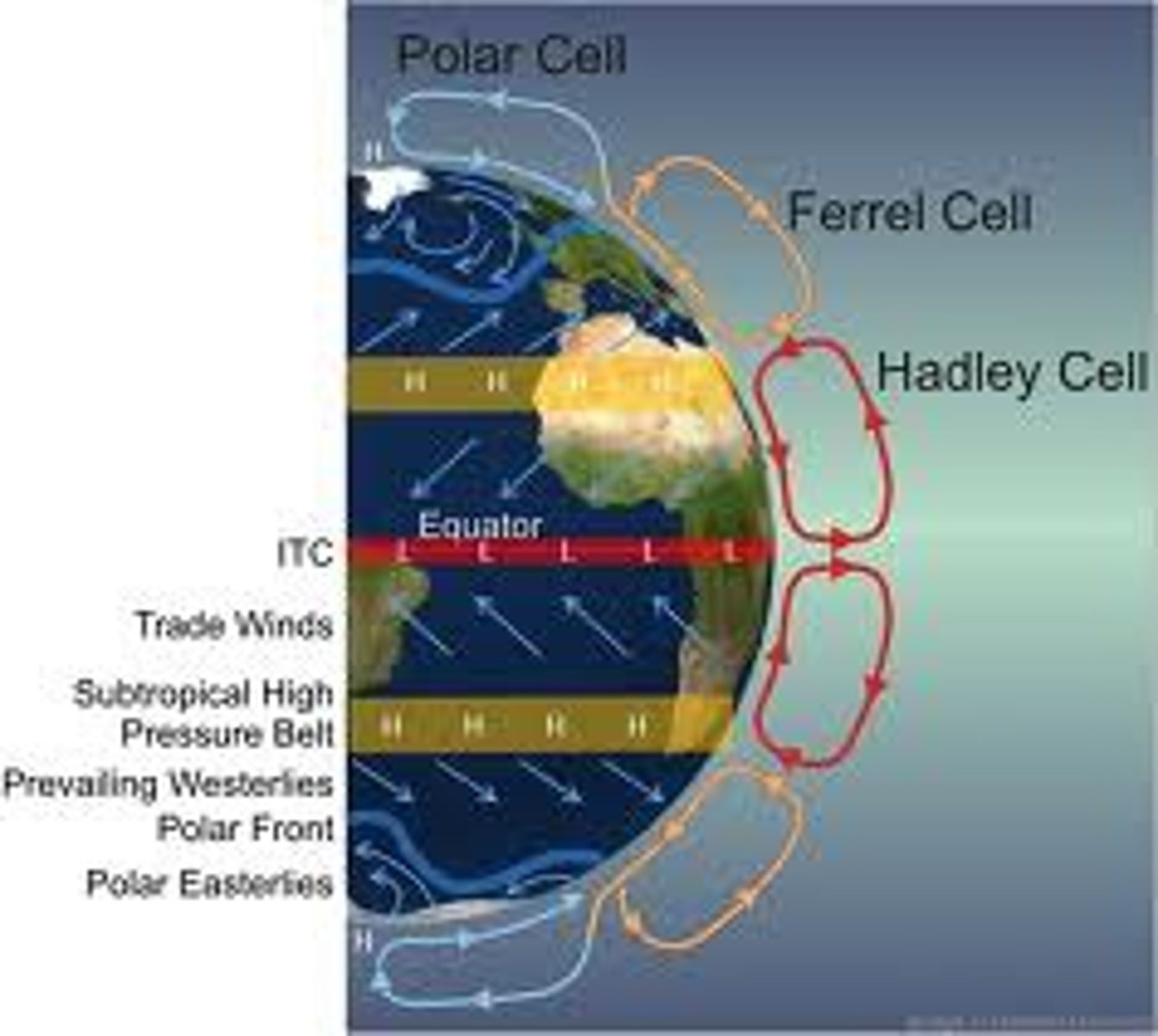
Polar cell
Cells of air circulation occurring between 60 degrees north and south and each pole.
Flows towards the poles where it cools and sinks.
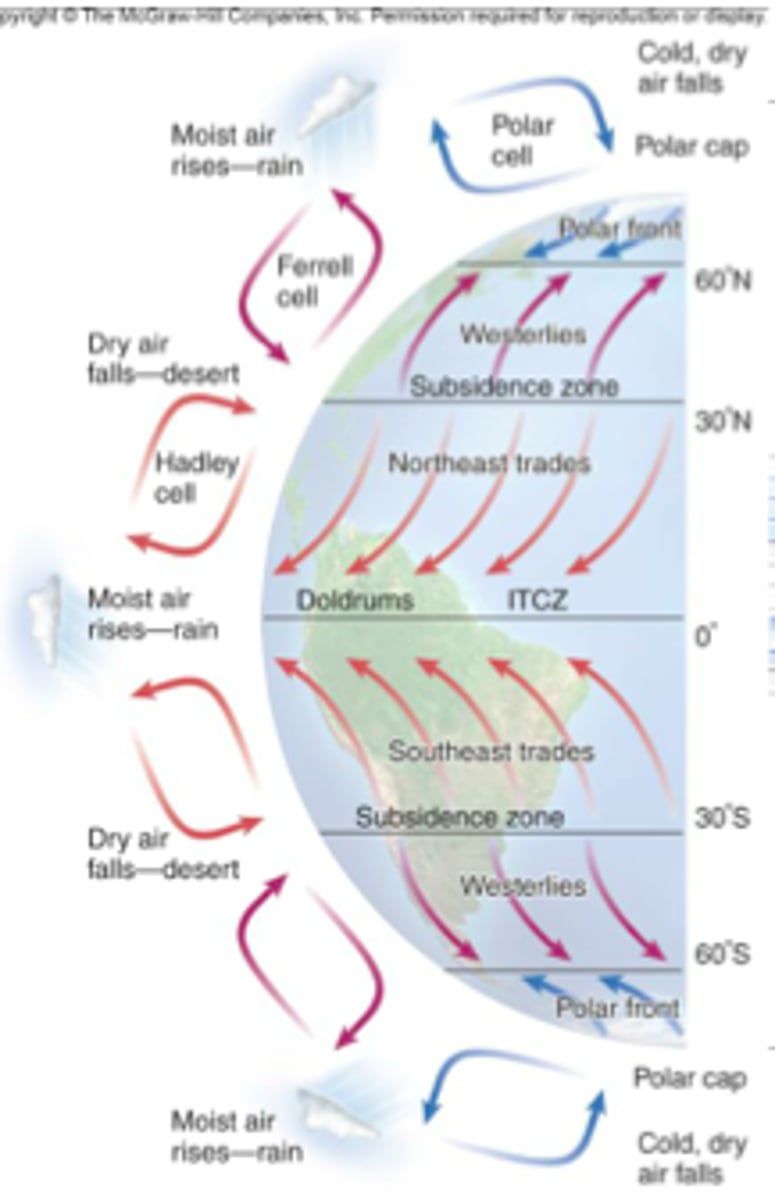
Ferrel cell
Moves opposite the air in Hadley and Polar cells
Is located between 30 and 60 degrees latitude
Is believed to be the result of air movement in the Hadley and Polar cells
- This reversed rotational movement presents some possibilities for why the mid-latitudes experience a wide range of weather
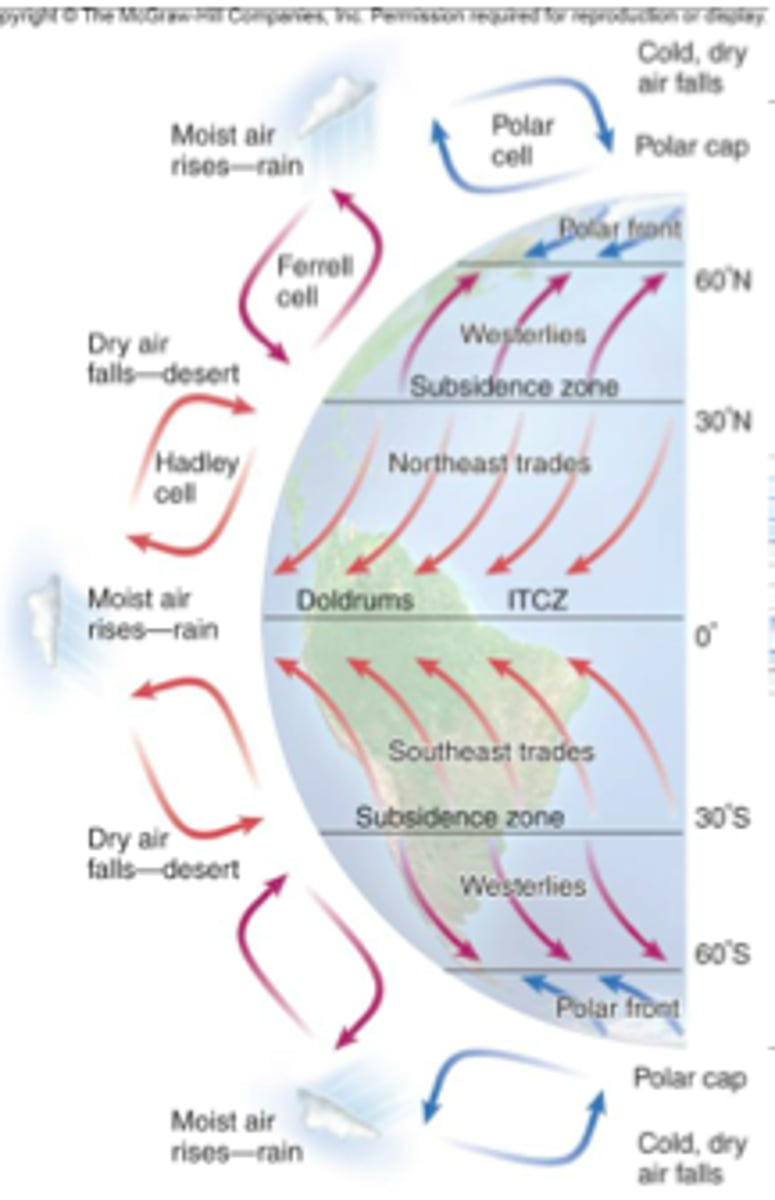
5 types of pressure systems
High - center of high pressure surrounded on all sides by lower pressure
Low - center of low pressure surrounded on all sides by higher pressure
Ridge - elongated area of relatively high pressure
Trough - elongated area of relatively low pressure
Col - neutral area between two highs or two lows or the intersection of a ridge and a trough
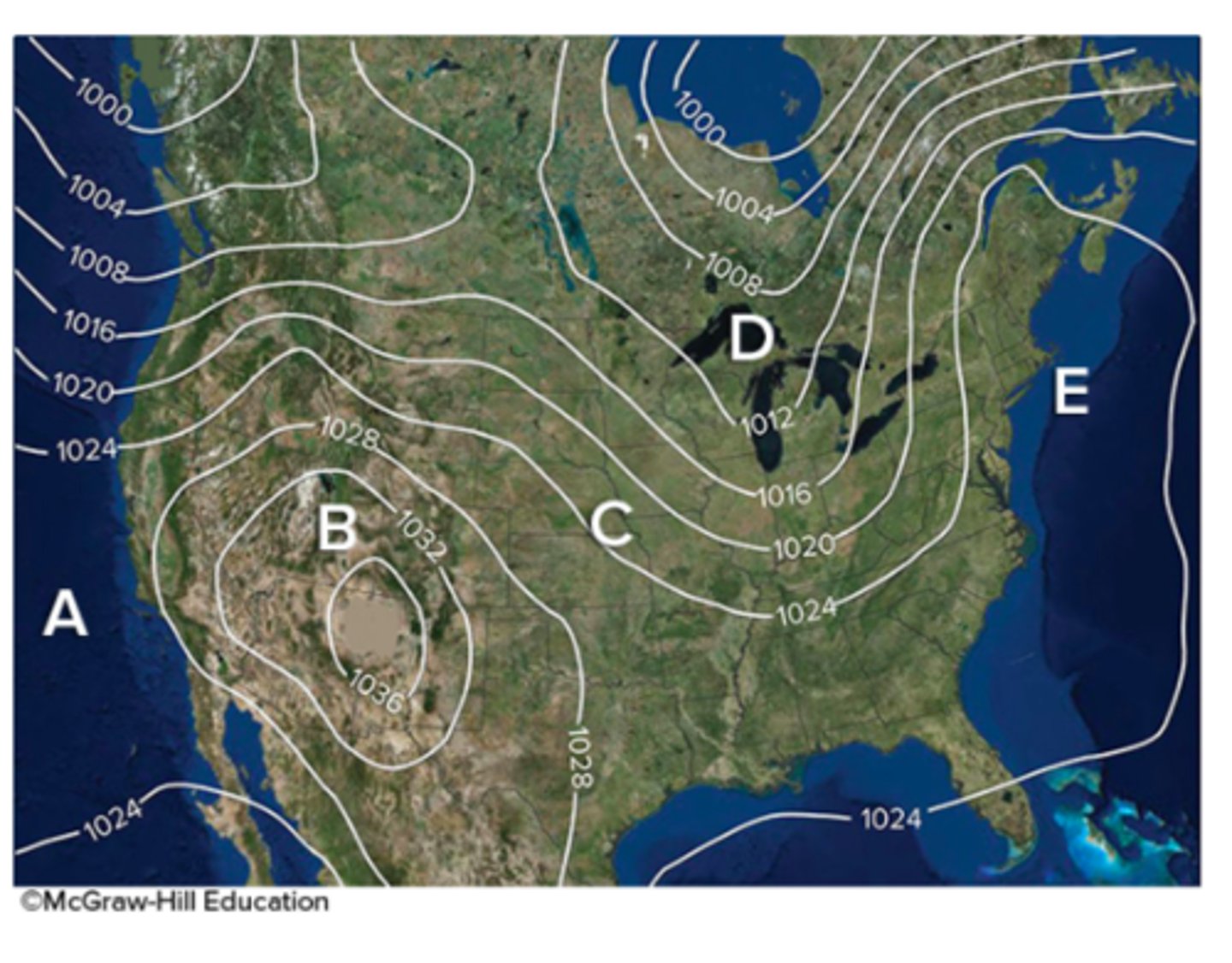
Coriolis Force
Influences the paths of all objects that move freely across the face of the earth
Deflects moving objects to the right in the northern hemisphere
Differs in amount of deflection depending on latitude
Differs with the speed of the moving object
Breaks up atmospheric circulation into the three-cell circulation model
Deflects wind until the Coriolis force and the pressure gradient are in balance
You have finished climbing and need to level off at your cruise altitude.
What is your primary visual reference to fly straight-and-level?
The horizon.
Instruments are used as backup.
You're flying straight-and-level. What do you use the pitch trim for?
To eliminate the need to apply continuous forward and back pressure on the control stick to maintain a constant pitch altitude.
You're in a straight-and-level flight and are having to continuously push forward on the control stick to keep from climbing.
What should you do with the trim control?
Trim the nose down.
What are the steps to establish the airplane? on a specific altitude and heading in a coordinated flight
-Maintain altitude and heading using outside visual references
cross check altitude and heading with the flight instruments
-Adjust the power to maintain the desired airspeed.
-Trim to relieve control pressures.
How do you reestablish the airplane on the desired flight path after a deviation?
-Use the flight instruments to determine the magnitude of the deviation
-Adjust the flight controls to return to the original altitude
Best Angle-of-Climb Speed
Vx Use to climb over obstacles near the airport
Best rate of climb speed
Vy Use to reach your cruise altitude as quickly as possible due to factors such as terrain clearance or ATC instructions.
Cruise Climb Speed
Use to increase groundspeed, forward visibility, and engine cooling with only a small reduction in climb rate.
How do you scan for traffic while climbing?
Lower nose periodically
Perform shallow S-turns
Transition to a cruise climb as soon as practical
When to level off after a climb
Begin leveling off at approx 10% of your climb rate below the desired altitude.
Example:
Climbing at 500 fpm
Begin leveling off about 50 feet below the desired altitude
To level off at 8,000 feet, begin reducing the pitch altitude at 7,950 feet
How to establish the climb attitude?
-Add power and apply back pressure on the control stick
- Add right rudder pressure to compensate for the left turning tendency
- Trim to relieve control pressures
How to maintain the climb attitude?
- Use outside visual references and cross check with the flight instruments
- Adjust the pitch to maintain airspeed
- Trim to relieve control pressures
Steps to level off out of climb
-Gradually lower the nose
- Maintain climb power to accelerate to cruise speed
- Reduce the right rudder pressure
How do you return to cruise flight?
Maintain the attitude for straight-and-level flight
- Reduce power to the cruise setting
- Trim to relieve control pressures
- Lean the mixture if necessary
How to control airspeed and descent rate?
- Adjust the power setting
- Adjust the pitch attitude
- Change the airplane configuration (extend flaps)
How to level off after a dscent?
Begin leveling off at approx 10% of your descent rate above the desired altitude.
For example:
Descending at 500 fpm
Begin leveling off about 50 feet above the desired altitude
To level off at 6,000 feet, begin reducing the pitch altitude at 6,050 feet
Cruise descent
When you need to fly at a lower cruising altitude.
Maintain cruise airspeed as you lose altitude.
How to establish the descent attitude?
- Reduce power slightly
- Let the nose pitch down a little
- Maintain the trim setting for cruise airspeed
Maintain the descent attitude
- Use outside visual references and cross check with the flight instruments
- Adjust the pitch to maintain descent rate and desired airspeed
- Trim to relieve control pressures
How to begin leveling off from a descent
- Gradually raise the nose
- Add power to maintain cruise speed
How to return to cruise flight after a descent?
- Establish attitude for straight-and-level flight
- Adjust power to maintain the cruise setting
- Trim to relieve control pressures
- Enrich the mixture if necessary
How to establish descent attitude?
- Reduce power to the approach power setting
- Gradually apply back pressure to the control stick to maintain attitude and slow the airplane to approach speed
- Let the nose pitch down to descend
- Extend the flaps in increments
How to maintain the descent attitude?
- Use outside visual references and cross check with the flight instruments
- Extend the flaps in increments
- Adjust the pitch and power to maintain the descent rate and desired airspeed
- Trim to relieve control pressures
How to begin leveling off from a descent?
- Gradually raise the nose
- Add power to maintain the desired airspeed
- Retract the flaps in increments